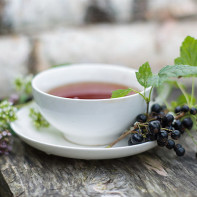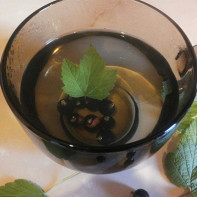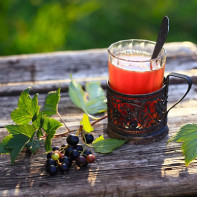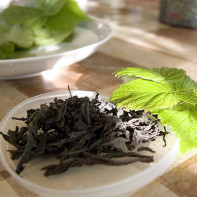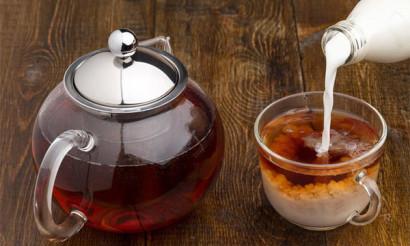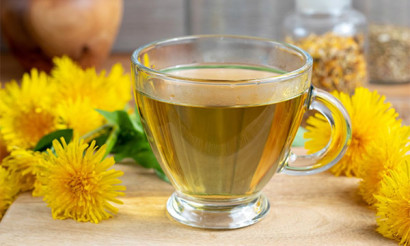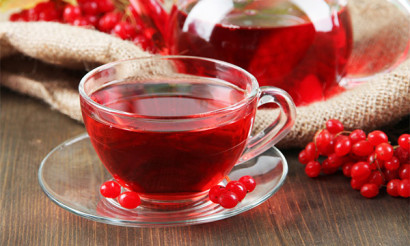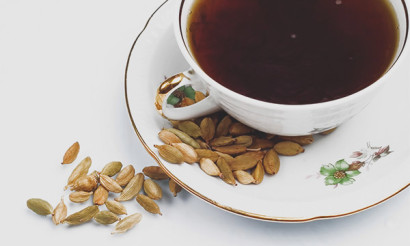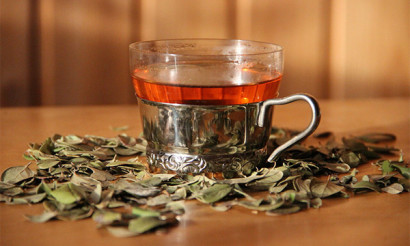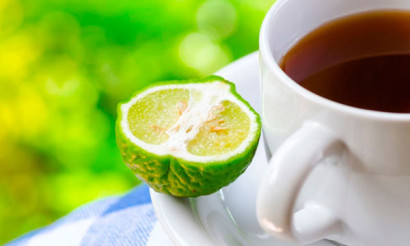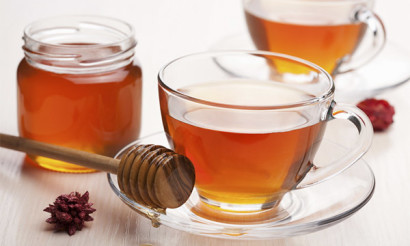Currant leaf tea: benefits and harms
Currant is an evergreen or decaying shrub, whose homeland is considered to be Central Asia and the south of Europe. Cultivate the plant began in the XI century. There is not a single person who at least once in his life has not tasted the fruits of this wonderful shrub. There are more than 180 species of this plant, but only black, red and white are common.
- When to collect currant leaves for tea
- How to dry leaves
- What leaves make tea: red or black currant
- Composition and calorie content
- What is useful tea from currant leaves
- For women
- For men
- During pregnancy
- When breastfeeding
- For kids
- Currant leaf tea in medicine
- Harm and contraindications
- How to make tea from currant leaves
- Classic recipe
- Leaves mix tea recipe
- Leaves and shoots recipe
- Interesting facts about blackcurrant
It is noteworthy, but in Europe they began to domesticate it initially as a medicinal plant and only after that they tasted the taste of its fruits. In Russia, the monks were the first to cultivate the shrub, they dug it in the forest and transplanted it to places near the temple. Currants love moisture and coolness, so it often grows on the banks of rivers. Some of them were even named in her honor, for example, "Currant". And the name of the bush comes from the word "stink", which then transformed into "currant".
Currant leaves are used in cooking and medicine due to the fact that they have useful macro-, microelements, essential oils, fatty acids and vitamins.
When to collect currant leaves for tea
Today the assortment of tea is so great that it is time to forget about any herbal infusions. However, as practice shows, everything happens exactly the opposite. This is because the leaves of certain plants help fight diseases, strengthen immunity and affect the quality of life without the use of drugs and expensive vitamin complexes.
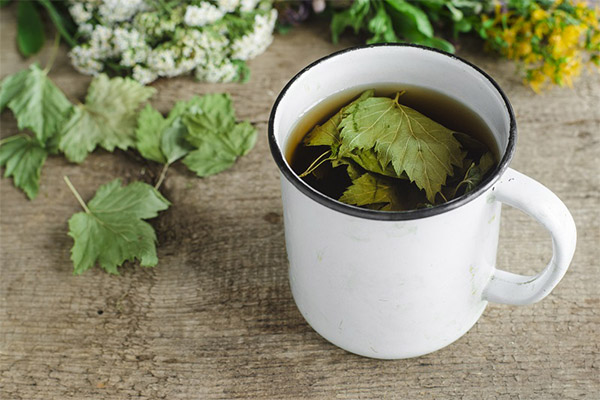
To enjoy the infusion on the leaves of currant, you need to know how to properly collect and dry them.
The infusion or tea made from currant leaves is tasty and fragrant, however, in order for it to be useful, you need to collect raw materials at certain times of the year. The best time to collect leaves for harvesting them for the winter is the flowering period of the plant. Typically, currants bloom in late May - early June. But there are also many new species that may bloom at other times. Therefore, you need to be guided not by the calendar schedule, but by the appearance of flowers on its stems.
An important factor is time. So, experienced specialists say that leaves need to be harvested between 10 a.m. and before 11-12, when there is already no dew on them, and the midday sun has not begun to bake. It is very important that there is no rain on this day, since the leaves will be wet and, most likely, they will not be able to dry - as a result, they can simply become moldy.
Also, most gardeners are advised to pay attention to the phases of the natural satellite of the earth - the Moon. It is believed that with its growth, currant leaves will contain the largest amount of vitamins and nutrients.
To summarize, there is nothing complicated in collecting currant leaves, the main thing is to follow simple rules, namely:
- wait for the flowering shrub;
- to collect raw materials in dry weather from 10 a.m. to noon;
- focus on the moon in the growth phase.
It is best to harvest young leaves that are not damaged and have not been attacked by diseases or pests.
How to dry leaves
Currant leaves need to be dried correctly, and this condition is true not only for them. If you do not adhere to certain rules, then you can easily spoil the raw materials, and all the work will be in vain.
Conditions for drying currant leaves:
- Heat.
- Low humidity.
- Access to fresh air.
- Lack of direct sunlight.
In other words, a place is required where it is warm, dry, no sun.If such a place is found, you need to lay out the collected leaves on a clean paper or cloth. Just a word of caution: you cannot use newspapers for this. The fact is that they have a printing ink that contains chemicals that are harmful and toxic to the human body. Therefore, when drying leaves on them, the paint will change their properties not for the better.
When the leaves are laid out for drying, they must be periodically checked for mold. Those leaves that were affected by it should be removed immediately, since it can spread to the entire "crop."
As soon as the leaves began to crumble, they can be removed for permanent storage. Keep leaves should also be correct. It is best to put them in cloth bags or an airtight container. It can be an ordinary glass jar if it is tightly closed by a lid.
Another option for harvesting currant leaves for the winter is the oven. This method is pretty good if there is no suitable place or it is limited in size. However, the disadvantage is that part of the beneficial properties are lost.
When drying currant leaves in the oven, they work like this:
- Leaves are laid out on a baking sheet, on clean paper or fabric in one layer.
- The oven is heated to approximately 100 ° C.
- Put the baking sheets in the oven, but do not close the door tightly.
- After 1 or 2 hours, the temperature is halved.
- Continue to dry until the leaves become brittle.
What leaves make tea: red or black currant
Currant leaves contain large amounts of vitamin C and tannins. This is what gives them value. However, black currants are used to brew tea, since its leaves contain more. As a rule, raspberry or cherry leaves are also used with them.
Composition and calorie content
If we talk about the energy value of currant leaves, then it is practically nonexistent. So, it is 0.1 kcal. Fats, proteins and carbohydrates are at the level of 0.01 g per 100 g of product.
But as for vitamins and minerals, then the picture is the opposite.
Vitamin C is one of the most important for the human body. It is involved in the absorption of iron, as well as in the restoration and growth of cells. In addition, it activates the protective functions of the body.
Trace elements:
- Manganese is an extremely important element. It directly affects blood sugar. A sufficient amount of it in the body is a natural prevention of diabetes. It also participates in cell division and reduces the effects of bad cholesterol. Manganese also promotes the growth of connective and cartilage tissue, which is important especially in childhood.
- Magnesium is a regulator. It affects the production of more than 300 enzymes that are responsible for the normal functioning of the muscle system, as well as for the transfer and storage of energy.
- Copper is another rather important element. Like manganese, it is involved in the absorption of iron by the body. It promotes energy production, as well as binds and neutralizes free radicals, which prevents premature aging.
In addition, currant leaves contain tannins, essential oils and volatile. The latter are slightly less than in garlic, but enough to fully provide the body with them.
What is useful tea from currant leaves
Tea or a decoction of currant leaves is very useful due to the presence in their composition of a large amount of vitamin C, macro- and microelements. He is able to significantly improve the condition of the patient. Tea made from currant leaves helps with respiratory diseases, and is also an excellent prophylactic. It stimulates the digestive tract, strengthens blood vessels, relieves constipation and heartburn.

For women
As mentioned earlier, currant leaf tea contains a large amount of vitamin C. For the female body, its value is difficult to overestimate.
Useful properties of vitamin C for women:
- This is a powerful antioxidant that directly affects the repair processes in the cells.
- It neutralizes the effect of free radicals, which are the cause of premature aging of the dermis.
- Stimulates the body's production of collagen, which gives the skin firmness and elasticity.
- Thanks to the activation of recovery processes, it improves the effect of any cosmetic procedures.
- Helps in removing age spots.
- Protects the dermis from UV exposure.
In addition, tea contains vitamin E (tocopherol), which is often called the "vitamin of youth." It improves the condition of the skin due to the activation of regenerative processes in the dermis and accelerated cell growth. Vitamin E is used for the production of creams, ointments and masks.
Tocopherol directly affects the lipid composition of the cells of the dermis, which makes the skin clean and beautiful, as well as the recovery processes in the hair follicles, which ensures density and their health.
For men
Blackcurrant leaf tea also has a significant effect on men. Fact - a strong half of humanity is most susceptible to diseases of the cardiovascular system. Thanks to magnesium and potassium, which are in the leaves of this wonderful plant, normal heart function is maintained. Also, a sufficient amount of these trace elements in itself is a prophylactic against most diseases associated with the cardiovascular system.
In addition, in the leaves of currant there are tannins that strengthen the genitourinary system and potency.
During pregnancy
Everyone knows that during pregnancy, the female body needs vitamins and minerals. Tea from currant leaves will be their source at any time of the year. This state of affairs is due to the ability of currants to retain useful properties in dried form. In fairness, it should be noted that during heat treatment they lose only a small part of them.
The benefits of tea from blackcurrant leaves during pregnancy:
- helps with colds, cystitis, bronchial diseases;
- normalizes stool;
- removes toxins and toxins from the body;
- beneficial effect on the digestive tract;
- indispensable for high cholesterol in the blood and diseases of the dermis.
Tea made from currant leaves also increases mental activity, calms the nervous system, prevents depression and fights anxiety. Also, a warm drink is an excellent diuretic, therefore, without harm to the body, removes unnecessary fluid from it, which is important for pregnant women.
In the first trimester, a decoction of currant leaves will help to cope with toxicosis.
Despite such a large list of positive properties, contraindications for pregnant women should also be considered:
- tendency to allergies;
- varicose veins;
- bleeding disorder;
- increased acidity in the stomach;
- gastrointestinal ulcer.
When breastfeeding
When breastfeeding, tea from currant leaves should be consumed sparingly and monitor the health of the mother and child. The fact is that currants can cause an allergic reaction. If the baby has a rash or irritation on the skin, then the broth should immediately stop drinking.
In general, tea from currant leaves positively affects the state of the body of the mother and child due to the many vitamins and elements:
- The work of the digestive tract improves, which is very important for breast-feeding.
- Slags and toxins are excreted from the mother’s body, which subsequently do not enter the baby’s body with breast milk.
- Milk of a young mother passes on vitamins A, C and E contained in currant leaves to the baby, which is extremely important for the normal development of the baby’s body.
- Currants also increase the immunity of both the mother and the child as a whole.
- Drinking a drink positively affects the development of the cardiovascular and nervous system.
For kids
For children, a decoction of currant leaves will also be extremely useful due to the high content of vitamin C. It is extremely important not only for adults, but also for a growing body. Vitamin C is directly involved in the process of cell division, which means it affects the formation of all types of tissues. In addition, it increases the protective functions of the body and has a beneficial effect on the functioning of the heart and nervous system. Tea also activates lipid metabolism, which is important for children who are obese.
If the child is active or does a lot of sports, tea from currant leaves will relax muscles and relieve fatigue.
But when using a decoction, you should carefully monitor your health. If signs of an allergic reaction appear, you should stop drinking the broth.
Currant leaf tea in medicine
Traditional medicine has recognized that currants contain essential vitamins and minerals that have therapeutic properties. Therefore, in the pharmacy you can find collections of herbs containing currant leaves.
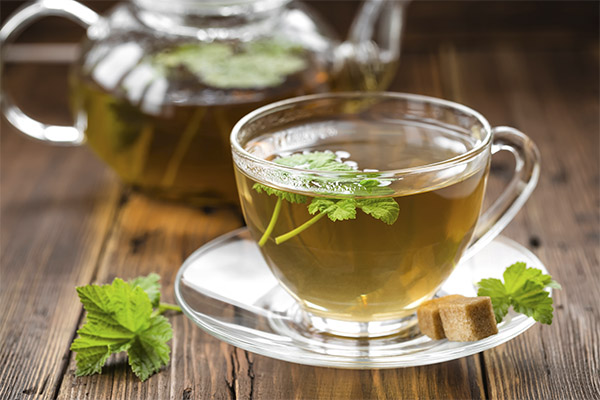
- Joint treatment. With rheumatism or arthritis, the anthocyanins contained in the leaves will help relieve inflammation and reduce pain when walking.
- The cardiovascular system. Rutin in currant leaves will help with varicose veins, and fatty acids will lower the amount of cholesterol in the blood, thus preventing the development of hypertension and reducing the risk of a heart attack.
- Nervous system and brain function. Currant leaves contain a lot of magnesium, which promotes the absorption of iron. This element is extremely important for saturating the brain with enough oxygen, which increases mental abilities. In addition, magnesium has a positive effect on the functioning of the nervous system, helps to cope with depression and anxiety.
- Lungs. With the help of tea from currant leaves, you can cure a sore throat, improve the condition of a patient with asthma, bronchitis. And vitamin C helps destroy the bacteria that cause coughing and bronchial disease.
- Gastrointestinal tract. Tannins stimulate digestion, normalize peristalsis, eliminate heartburn and constipation. That is why with a disorder of the digestive tract it is so important to use a decoction of currant leaves.
A decoction of currant leaves is most often used in the treatment of colitis, joint pain, to improve the digestive tract and increase immunity.
Harm and contraindications
In addition to useful properties, you can not drink tea from currant leaves:
- In case of blood coagulation, namely, with thrombophlebitis, since coagulation increases with regular use.
- Inflammatory processes in the digestive tract, high acidity or ulcer.
- Chronic diseases (before use it is necessary to consult a therapist).
How to make tea from currant leaves
In addition to the fact that currant leaves have useful properties, teas and decoctions from them are very tasty.
Classic recipe
What is needed:
- Black tea - 1 tsp
- Dried currant leaves - 2 tsp
How to cook:
- Dried currant leaves must be chopped and placed in a teapot.
- Put tea there.
- Pour boiling water over everything.
- Insist for at least 20-30 minutes.
You can drink not only hot, but also cold, with sugar or honey.
Leaves mix tea recipe
What is needed:
- Dried strawberry and raspberry leaves in 1 part.
- Dried currant leaves - 2 parts.
How to cook:
- Leaves must be chopped and rinsed if necessary.
- Place the mixture of dried leaves in a teapot and pour boiling water (1/2 L).
- Let it brew for at least 15 minutes.
Serve with honey or sugar.
Leaves and shoots recipe
In summer, you can cook an excellent vitamin complex that will be useful to everyone, for this you will need:
- Young shoots of currant with buds not yet opened.
- 2-3 tsp dried currant leaves.
How to cook:
- It is necessary to cut young shoots of currant.
- Wash and place in boiling water for 2-3 minutes.
- Then pour the chopped leaves into the teapot and pour boiling water in which there were shoots.
- Let it brew for at least 20 minutes.
Interesting facts about blackcurrant
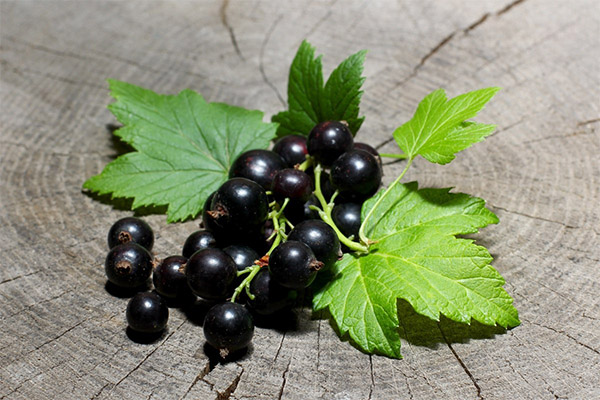
- The monks were the first to cultivate currants both in Europe and in Russia.
- The closest relative of the currant is gooseberry, and the distant are the incense and the money tree, as well as the peony.
- There are more than 180 species of currant; it grows on all continents, except Australia and Antarctica.
- Despite the rather late domestication of the plant, its healing properties were known even in ancient Rome and Greece.
- In Russian epics and legends, the name of the river Smorodinovka is very common. Historians believe that in ancient times the Moscow River was called.
- Since currants grew in almost every temple, it was called the “monastery berry”.
- Unripe currant berries contain 3-5 times more vitamin C than ripe.
- Vitamins, macro- and microelements are found in all parts of the bush, even in the root.
- Blackcurrant contains more vitamins if it grows in a rather harsh climate. Plants in the southern regions contain significantly less.
- There is no other fruit or vegetable where there would be more vitamin B5, which enhances immunity and makes skin and hair beautiful and healthy.
- Blackcurrant leaves are used for preservation to saturate with vitamin C and phenolic compounds that prevent premature spoilage. Therefore, preservation can be stored much longer.
- Blackcurrant has a bright expressive smell due to the high content of essential oils.
- Currant is one of the few berries that remove radioisotopes from the human body. This feature became known after the accident at the Chernobyl nuclear power plant. Now, those who work in hazardous production, recommends consuming the fruits of this plant.
- Blackcurrant contains very few calories, so you can not worry about the figure when eating berries.
- Currant is a melliferous plant, from which an unusually tasty and healthy honey is obtained.
- When drying the leaves and fruits of blackcurrant, all vitamins and nutrients are fully preserved.
- There is more vitamin C in blackcurrant fruits than in orange or tangerine.
- Most of all, blackcurrant is grown on an industrial scale in Russia, in second place is Poland, and in third is Germany.
«Important: all information on the site is provided exclusively in fact-finding purposes. Before applying any recommendations, consult with a profile specialist. Neither the editors nor the authors are liable for any possible harm caused materials. "

